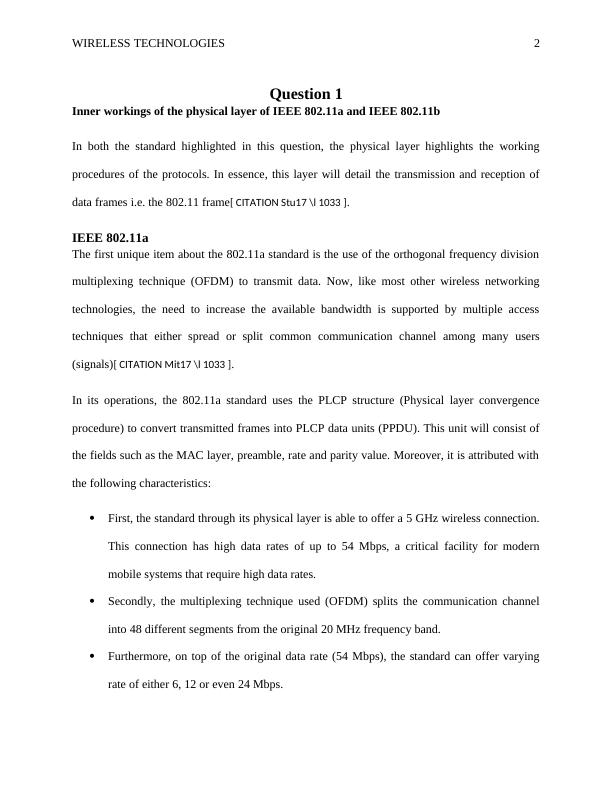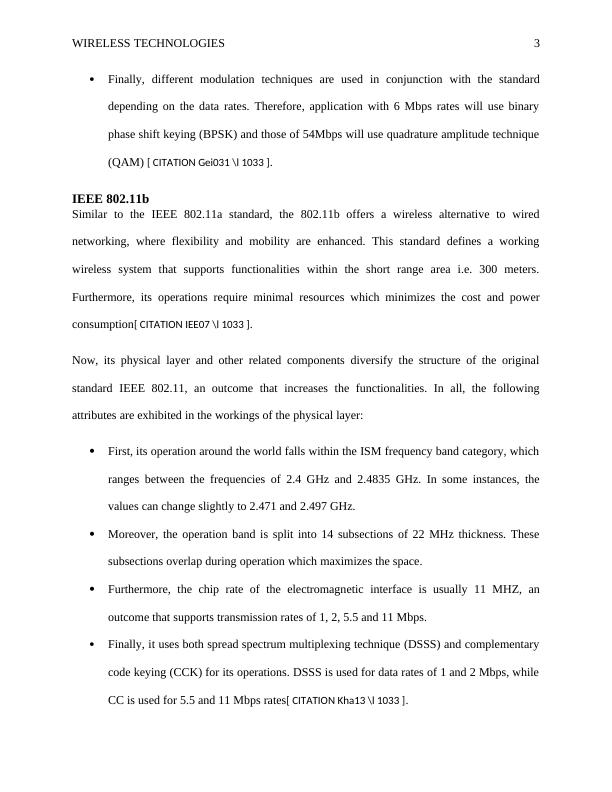Inner Workings of the Physical Layer of IEEE
11 Pages2500 Words82 Views
Added on 2020-04-01
Inner Workings of the Physical Layer of IEEE
Added on 2020-04-01
ShareRelated Documents
Running head: WIRELESS TECHNOLOGIESAssignment [Student Name Here][Institution’s Name Here] [Professor’s Name Here][Date Here]

WIRELESS TECHNOLOGIES2Question 1Inner workings of the physical layer of IEEE 802.11a and IEEE 802.11bIn both the standard highlighted in this question, the physical layer highlights the workingprocedures of the protocols. In essence, this layer will detail the transmission and reception ofdata frames i.e. the 802.11 frame[ CITATION Stu17 \l 1033 ].IEEE 802.11aThe first unique item about the 802.11a standard is the use of the orthogonal frequency divisionmultiplexing technique (OFDM) to transmit data. Now, like most other wireless networkingtechnologies, the need to increase the available bandwidth is supported by multiple accesstechniques that either spread or split common communication channel among many users(signals)[ CITATION Mit17 \l 1033 ].In its operations, the 802.11a standard uses the PLCP structure (Physical layer convergenceprocedure) to convert transmitted frames into PLCP data units (PPDU). This unit will consist ofthe fields such as the MAC layer, preamble, rate and parity value. Moreover, it is attributed withthe following characteristics:First, the standard through its physical layer is able to offer a 5 GHz wireless connection.This connection has high data rates of up to 54 Mbps, a critical facility for modernmobile systems that require high data rates.Secondly, the multiplexing technique used (OFDM) splits the communication channelinto 48 different segments from the original 20 MHz frequency band.Furthermore, on top of the original data rate (54 Mbps), the standard can offer varyingrate of either 6, 12 or even 24 Mbps.

WIRELESS TECHNOLOGIES3Finally, different modulation techniques are used in conjunction with the standarddepending on the data rates. Therefore, application with 6 Mbps rates will use binaryphase shift keying (BPSK) and those of 54Mbps will use quadrature amplitude technique(QAM) [ CITATION Gei031 \l 1033 ].IEEE 802.11bSimilar to the IEEE 802.11a standard, the 802.11b offers a wireless alternative to wirednetworking, where flexibility and mobility are enhanced. This standard defines a workingwireless system that supports functionalities within the short range area i.e. 300 meters.Furthermore, its operations require minimal resources which minimizes the cost and powerconsumption[ CITATION IEE07 \l 1033 ].Now, its physical layer and other related components diversify the structure of the originalstandard IEEE 802.11, an outcome that increases the functionalities. In all, the followingattributes are exhibited in the workings of the physical layer:First, its operation around the world falls within the ISM frequency band category, whichranges between the frequencies of 2.4 GHz and 2.4835 GHz. In some instances, thevalues can change slightly to 2.471 and 2.497 GHz.Moreover, the operation band is split into 14 subsections of 22 MHz thickness. Thesesubsections overlap during operation which maximizes the space.Furthermore, the chip rate of the electromagnetic interface is usually 11 MHZ, anoutcome that supports transmission rates of 1, 2, 5.5 and 11 Mbps.Finally, it uses both spread spectrum multiplexing technique (DSSS) and complementarycode keying (CCK) for its operations. DSSS is used for data rates of 1 and 2 Mbps, whileCC is used for 5.5 and 11 Mbps rates[ CITATION Kha13 \l 1033 ].

WIRELESS TECHNOLOGIES4Highlights:802.11a802.11bFreq band: 5 GHzFreq band: 2.4 GHzData rate: 54 MbpsData rate: 11 MbpsModulation techniques: BPSK and QAMModulation techniques: DSSS and CCKQuestion 2a. 802.11iLike most standards seen today, the 802.11i standard is an advancement of an original standardi.e. the 802.11. Now, this general standard (802.11) offers security to wireless systems throughdata encryption and authentication. In the original protocol, the basic WPA (Wi-Fi protectedaccess) was used to restrict access to wireless LAN. However, as experienced today, thisprotocol has very many limitations that expose the content used. Therefore, the 802.11i wasdeveloped to address these shortcomings by employing the WPA2 protocol. This protocolrefined the security standards by increasing the authentication requirements and by supporting itsoperations using AES encryption (Advanced Encryption Standard)[ CITATION Rad17 \l 1033 ].For a client trying to access a server, the standard introduced new access mechanisms includingrobust security network which uses a four-way handshake. This handshake is completed by agroup keying system that uses the extensible authentication protocol (EAP)[ CITATION eTu17 \l1033 ]. Therefore, the following procedure is followed:The client initiates the access process by sending an EAP message (notification).Its access point also sends an EAP message to identify itself.The client responds an outcome that encrypts its operations to both authenticator and theserver.The server challenges the client to prove its identity.

End of preview
Want to access all the pages? Upload your documents or become a member.
Related Documents
Wireless Networks Assignmentlg...
|12
|2732
|95
Wireless Digital Communications Assignmentlg...
|9
|1877
|266
Wireless Connectivity- Assignmentlg...
|9
|2154
|31
Outlines a Wireless Local Area Networklg...
|9
|2033
|187
The Operational Range of Frequencylg...
|8
|1886
|54
Networking Assignment | Wireless Sensor Networklg...
|13
|2886
|64
